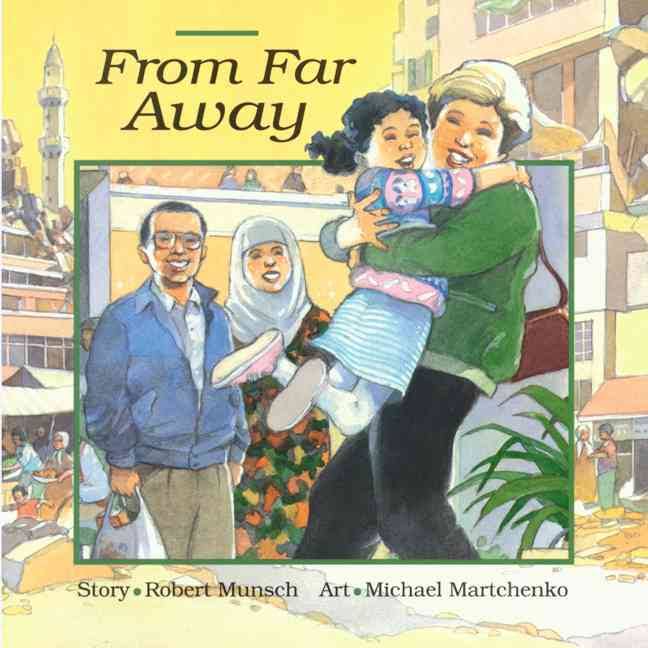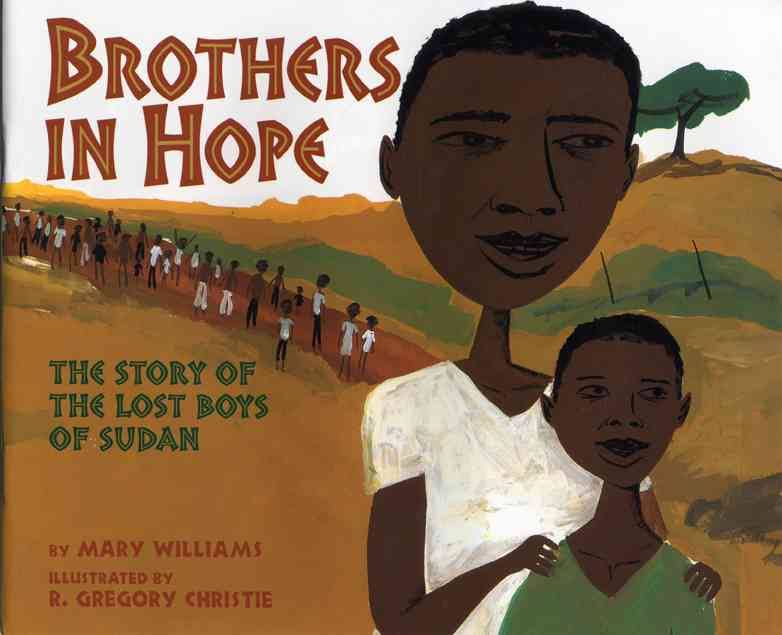From Far Away

A little girl named Saoussan Askar, who was born in Beirut, Lebanon, moved to Ontario and began to send letters about her experiences as an immigrant to Robert Munsch. He wrote a story about it, and in the typical Munsch style, the book is entertaining and endearing. The story is written in the form of a letter.
Age appropriate: 5+
(Great read aloud!)
Breadwinner
Deborah Ellis

When Parvana's father is arrested, she has no other choice but to disguise herself as a boy and work so that her family can eat. This story carries all the breadth of life of war-torn Afghanistan, : laughter, heartache, courage and fear. An unforgettable read, and based on true stories of children Ellis met in refugee camps.
Age appropriate: 11+
(graphic violence)
Aram's Choice
Marsha Forchuk Skrypuch

Age Appropriate: 9+
Everybody Cooks Rice
Norah Dooley

A number of multicultural families live near each other--the one thing they have in common is that they all cook rice. The book includes recipes to make with your child.
Age Appropriate: Primary levels
Brothers in Hope: The Story of the Lost Boys of Sudan
Mary Williams

Eight-year old Garang must escape from his country, Sudan, and then join hundreds of boys fleeing to find refuge from war. On the way he makes new friends and discovers the importance of education. A book about courage and perseverance.
Winner of the 2006 Coretta Scott King Award.
Age appropriate 8+
The Arrival
Shaun Tan

It's my opinion that anyone, adults especially, who would like to experience what it feels like to be immersed into a completely different culture, should read this book. There are no words, only images, and like any foreigner new to a place who does not yet know the language, you have to decipher what is happening in the story along with the protagonist. The illustrations are remarkable, a true classic.
Age Appropriateness: All
Fatima
Frederick Lipp

When Billy starts to make fun of Fatima's mother at school, Fatima makes the brave choice to wear her own hijab and talk to fellow students about respect. As her mother explains to her, "It's not what I look like, but what I say and do that matters." This is an engaging, moving, and informative story for all students who do not know about the purpose of the hijab or generally about Islam. Check out other stories by Frederick Lipp.
Age Appropriate: 7+
Sami and the Time of the Troubles
Florence Parry Heide and Judith Heide Gilliland

In war-torn Lebanon, Sami learns about what it means to hope for a brighter future. Enjoy the beautiful, evocative illustrations by Ted Lewin.
Age Appropriate: 10+
The Lion's Mane
Navjot Kaur

This is another great read-aloud for school children. In The Lion's Mane, children will learn about the Sikh religion and why some people wear turbans. The book is easy to read and engaging with lively illustrations to go along with the meaningful text.
Age Appropriate: 5 +
Four Feet, Two Sandals
Karen Lynn Williams and Khadra Mohammed

This beautifully told and brightly illustrated book depicts what life can be like in a refugee camp. Without making the situation too dark and depressing, the author chooses to focus on one difficulty that even the youngest of readers can relate to: not having shoes. Through this one detail, a young reader can pick up the book's themes of compassion and hope.
Age Appropriate: 5+
Robert Munsch
A little girl named Saoussan Askar, who was born in Beirut, Lebanon, moved to Ontario and began to send letters about her experiences as an immigrant to Robert Munsch. He wrote a story about it, and in the typical Munsch style, the book is entertaining and endearing. The story is written in the form of a letter.
Age appropriate: 5+
(Great read aloud!)
Breadwinner
Deborah Ellis
When Parvana's father is arrested, she has no other choice but to disguise herself as a boy and work so that her family can eat. This story carries all the breadth of life of war-torn Afghanistan, : laughter, heartache, courage and fear. An unforgettable read, and based on true stories of children Ellis met in refugee camps.
Age appropriate: 11+
(graphic violence)
Aram's Choice
Marsha Forchuk Skrypuch

Aram is chosen with fifty other boys to go to Canada. He has just survived the Armenian genocide and is determined to find a way to bring money home for his grandmother. Readers will enjoy this book on several levels: historical, pedagogical, religious, social, and artistic.
Canadian Library Association Book of the Year for Children shortlist, 2007
Golden Oak nominee, 2008Age Appropriate: 9+
Everybody Cooks Rice
Norah Dooley
A number of multicultural families live near each other--the one thing they have in common is that they all cook rice. The book includes recipes to make with your child.
Age Appropriate: Primary levels
Brothers in Hope: The Story of the Lost Boys of Sudan
Mary Williams
Eight-year old Garang must escape from his country, Sudan, and then join hundreds of boys fleeing to find refuge from war. On the way he makes new friends and discovers the importance of education. A book about courage and perseverance.
Winner of the 2006 Coretta Scott King Award.
Age appropriate 8+
The Arrival
Shaun Tan
It's my opinion that anyone, adults especially, who would like to experience what it feels like to be immersed into a completely different culture, should read this book. There are no words, only images, and like any foreigner new to a place who does not yet know the language, you have to decipher what is happening in the story along with the protagonist. The illustrations are remarkable, a true classic.
Age Appropriateness: All
Fatima
Frederick Lipp

When Billy starts to make fun of Fatima's mother at school, Fatima makes the brave choice to wear her own hijab and talk to fellow students about respect. As her mother explains to her, "It's not what I look like, but what I say and do that matters." This is an engaging, moving, and informative story for all students who do not know about the purpose of the hijab or generally about Islam. Check out other stories by Frederick Lipp.
Age Appropriate: 7+
Sami and the Time of the Troubles
Florence Parry Heide and Judith Heide Gilliland
In war-torn Lebanon, Sami learns about what it means to hope for a brighter future. Enjoy the beautiful, evocative illustrations by Ted Lewin.
Age Appropriate: 10+
The Lion's Mane
Navjot Kaur

This is another great read-aloud for school children. In The Lion's Mane, children will learn about the Sikh religion and why some people wear turbans. The book is easy to read and engaging with lively illustrations to go along with the meaningful text.
Age Appropriate: 5 +
Four Feet, Two Sandals
Karen Lynn Williams and Khadra Mohammed
This beautifully told and brightly illustrated book depicts what life can be like in a refugee camp. Without making the situation too dark and depressing, the author chooses to focus on one difficulty that even the youngest of readers can relate to: not having shoes. Through this one detail, a young reader can pick up the book's themes of compassion and hope.
Age Appropriate: 5+










